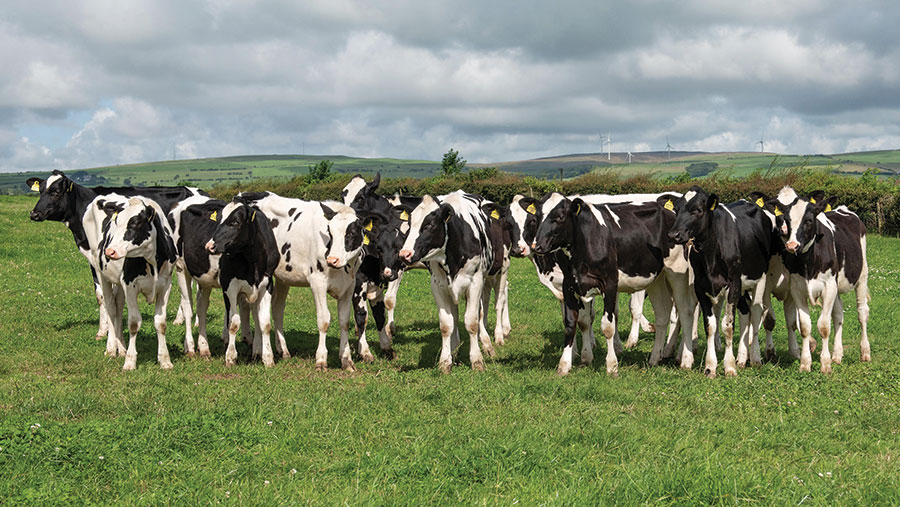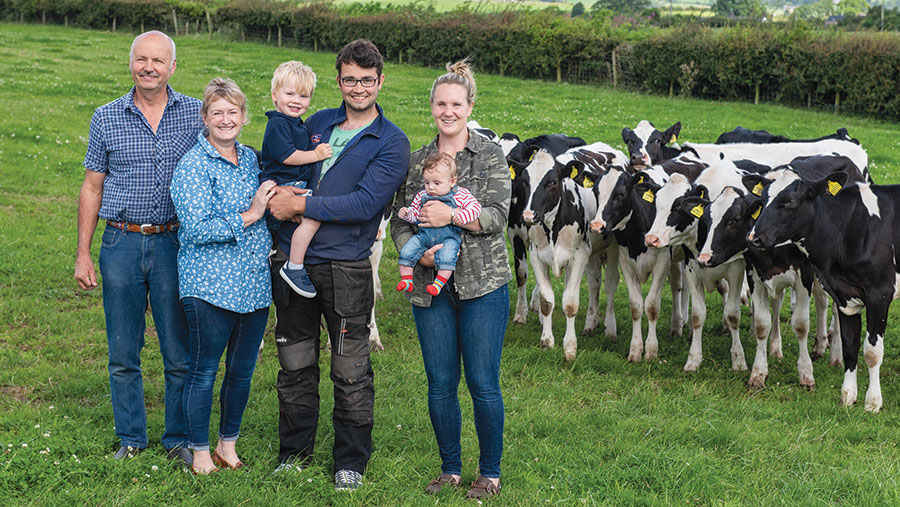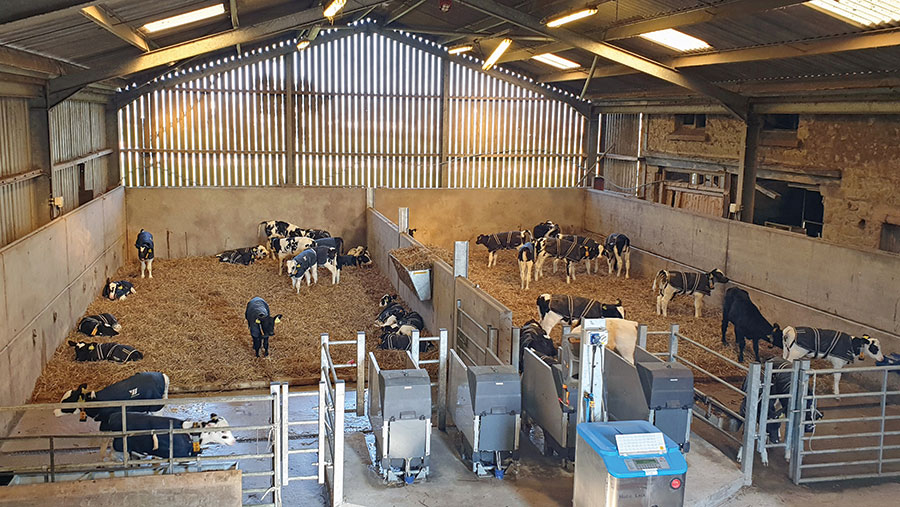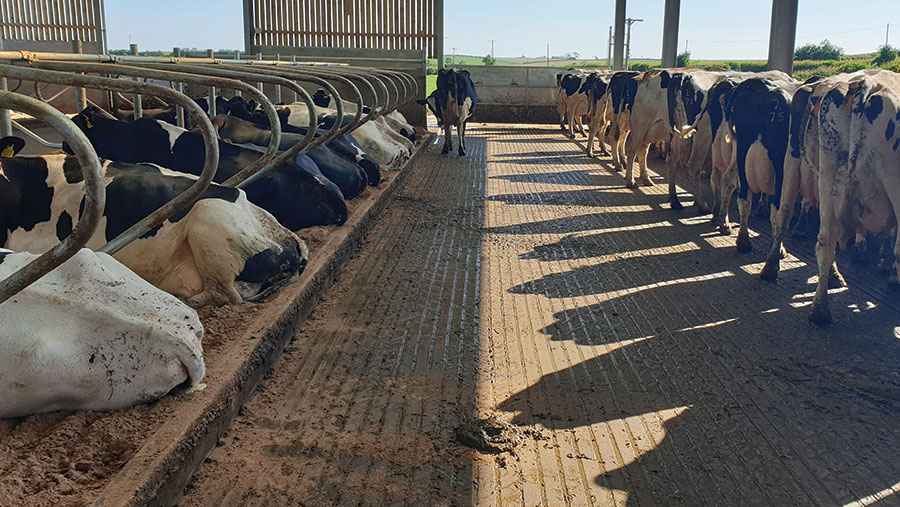Why ice cream venture is key to succession on family farm
 The next generation - Boltonmanor Holstein heifers
The next generation - Boltonmanor Holstein heifers When Tom Stable and his wife Anna returned home to join his parents, Mike and Denise, at Bolton Manor dairy farm, near Ulverston, six years ago, they soon realised the only way to provide enough income for both couples was to expand.
In 2013, they added a second dairy unit, Edge Hill Farm, under a tenancy, taking the overall farmed area to about 200ha.
However, a year later, the milk price plummeted, incomes fell and the Stables were forced to look beyond milk production to generate sufficient revenue.
See also: How one dairy farm set up a processing unit to sell direct
Ice cream venture
After considering their options, the family decided ice cream production fitted well with the existing business.
The Stables also realised that, with the farms located close to the tourist honeypots of South Lakeland and Morecambe Bay, there was a sizeable market to target.
Mike and Denise initially invested £60,000 to convert the dairy at Edge Hill into a retail outlet, ice cream parlour and a small café with seating in the yard. A second-hand, 60-litre pasteuriser and batch freezer were added later.

From left: The Stable family, Mike, Denise, Alfie, Tom and Anna, with baby Toby
Denise went on an ice cream-making course with specialist training provider RSS Hereford, and visited trade fairs and local businesses to gain more knowledge. Food hygiene training was also a necessity.
With the investments, training and fact-finding complete, Cumbrian Cow Ice Cream finally opened in May 2016. The venture has been promoted through Facebook and word of mouth, with additional footfall gained from visitors doing Google and TripAdvisor searches.
Farm facts
- 290 milking cows
- Average milk yield of 10,400 litres a cow at 3.95% butterfat and 3.28% protein
- 200ha, half owned, half rented
- 45ha maize, 90ha grass silage,35ha grazed and 30ha wheat
Marketing has been an overwhelming success, with the couple estimating they have 80,000 customers a year.
But it takes a lot of effort to meet that much demand. Even though the diversification employs 14 people, Denise makes all the ice cream herself, which means spending up to six hours a day in the kitchen.
“I don’t work in the shop now. I’ll have about 60 pans of fresh ice cream made at the start of each day,” she says.
Each pan contains 5 litres of ice cream and the shop’s display cabinet holds 16 litres. Matching production to demand also takes skill, because sales are heavily weather dependent.
“If it is a dull morning, business is slow. If the sun comes out, within half an hour, business can have doubled,” says Denise.
It means watching the weather carefully and ramping up production to ensure they have sufficient stocks if a sunny weekend is forecast.
“On a good day, the cabinet can be refilled several times and we will probably sell 200 litres of ice cream,” Denise reckons.
The ice cream is produced in 80 different flavours and commands a premium at £2.40 a scoop or £6.80 for a 1-litre bucket.
The ice cream adds a significant margin to the milk, despite the cost of other ingredients such as sugar and flavourings.
Running two businesses
During the six months of the year when the ice cream parlour is open, milk is bought from the farm business.
“We had to inform the milk buyer that we were putting some of the milk into another market,” says Mike.
The ice cream business takes about 1% of Bolton Manor’s production, or about 10,000 litres of milk, so it does not affect the forecasts, he adds.
Mike tends to work across the two enterprises and he advises anyone taking on a diversification not to spread themselves too thinly.
“When we took on the tenancy at Edge Hill Farm, we didn’t appreciate how much more difficult it is to run two different sites, even though they are only two miles apart,” he says.

The herd is approaching 300 head, with 180 dairy youngstock and 70 store cattle.
Adding the ice cream venture complicated things further, Mike adds.
“We’re still farmers first and foremost, and we have realised the core business has to be stable and successful before you diversify,” he advises.
“It’s exceptionally difficult to control two separate businesses, so you must have someone who concentrates on one business to do a good job of it,” Mike says.
Top tips for ice cream production
- Make the ice cream fresh on a daily basis
- Watch the weather forecast to gauge demand
- Have one person making the ice cream to ensure consistency
- Product presentation is key
- Market the product on social media
- Don’t underestimate the demand
Milk production
That policy and belief is borne out by the continuing success of the dairy unit, which generates as much as 75% of the overall farm income through milk sold to Arla.
Mike has stepped back, acting as troubleshooter and co-ordinator for the businesses, and Tom and Anna have been able to focus on developing the pedigree Holstein herd while introducing better feeding and other management changes.
Cow numbers have been increased from 200 since the tenancy was taken on at Edge Hill to almost 300 head, plus 180 dairy youngstock and 70 store cattle.
There are 47 Ex cows in the herd,109 are classified VG and 94 GP.
Higher-yielding cows were switched to year-round housing in a new 126-place, sand-bedded cubicle shed last year, while the lower-yielders still remain at grass through the summer.
As well as increased cow comfort, the building has a robotic feed pusher and LED lighting. The LEDs minimise the cost of lighting the shed for 16 hours a day throughout the winter.
The changes have helped increase average yields across the herd from 9,000 to 10,400 litres a head.
Nutrition
Better nutrition has also played a significant role.

As well as cow comfort with the sand bedding and extra space for the milking cows which are housed year round, the building has a robotic feed pusher
The cows are fed to produce the best milk constituents possible, as that is what Arla wants, and the Stables also look for a constant fat content for the ice cream, says Mike.
Despite the northerly position of the farm, Tom has introduced maize, grown under plastic, to replace wholecrop and boost energy levels in the diet.
Three-quarters of the dairy cows’ diet is home-grown and fed as a complete diet, topped up to yield in the parlour.
Tom also attributes the increased yields to weekly instead of fortnightly vet visits, which have helped improve the pregnancy rate from 17% in 2017 to 25% this year.
The future
“With both farms working well, we want to ensure we maintain our high standards while improving the efficiency of our production processes,” Mike says.
For the ice cream business, he wants to build on the positive message the venture has given to the public.
“People are fascinated by the farm and what we do. It is a good opportunity to educate them and tell our side of the story, so we’ll get some more animals on display and improve the farm experience,” Mike says.
